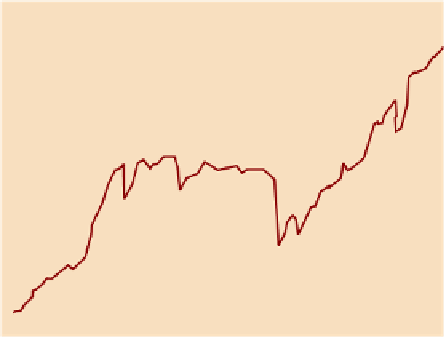Geology Reference
In-Depth Information
?
Permian, a meteorite impact such as occurred at the end of
the Cretaceous Period (see Chapter 22) can be reasonably
discounted.
A reduction in the habitable marine shelf area caused by
the formation of Pangaea and a widespread marine regression
resulting from glaciation can also be rejected as the primary
cause of the extinctions. By the end of the Permian, most col-
lisions of the continents had already taken place, such that the
reduction in the shelf area had already occurred before the mass
extinctions began in earnest. Furthermore, the widespread gla-
ciation that took place during the Carboniferous was now wan-
ing in the Permian.
What Would You Do
One concern of environmentalists is that environmental deg-
radation is leading to vast reductions in global biodiversity. As
a paleontologist, you are aware that mass extinctions have
taken place throughout Earth history. What facts and informa-
tion can you provide from your geologic perspective that will
help focus the debate on whether or not Earth's biota is being
adversely affected by such human activities as industrializa-
tion, and what the possible outcome(s) might be if global
biodiversity is severely reduced?
Currently, many scientists think
that an episode of deep-sea anoxia
resulted in a highly stratifi ed ocean
during the Late Permian. In other
words, there was very little, if any,
circulation of oxygen-rich surface
waters into the deep ocean. During
this time, stagnant waters also cov-
ered the shelf regions, thus affecting
the shallow marine fauna.
During this time (Late Perm-
ian), widespread volcanic and con-
tinental fi ssure eruptions were also
taking place, releasing additional
carbon dioxide into the atmosphere
and contributing to increased cli-
matic instability and ecologic col-
lapse. By the end of the Permian, a
near collapse of both the marine and
terrestrial ecosystem had occurred.
Although the ultimate cause of such
devastation is still being debated
and investigated, it is safe to say that
it was probably a combination of interconnected and related
geologic and biologic events.
Image not available due to copyright restrictions
900
1 Late Ordovician (
-
12%)
2 Late Devonian (
-
14%)
3 Late Permian (
-
52%)
4 Late Triassic (
-
12%)
5 Late Cretaceous (
-
11%)
A
chordate
(phylum Chordata) is an animal that has, at
least during part of its life cycle, a notochord, a dorsal hol-
low nerve cord, and gill slits (
600
Figure 21.14).
Ve r t e b r a t e s
,
which are animals with backbones, are simply a subphylum
of chordates.
The ancestors and early members of the phylum Chordata
were soft-bodied organisms that left few fossils (
◗
5
2
300
1
Figure 21.15).
Consequently, we know little about the early evolution-
ary history of the chordates or vertebrates. Surprisingly, a
close relationship exists between echinoderms (Table 21.1)
and chordates, and they may even have shared a common
ancestor. This is because the development of the embryos
of echinoderms and chordates are the same in both groups,
that is, the cells divide by radial cleavage so that the cells
are aligned directly above each other (
◗
4
3
0
-C OSDCP
R
J
K T
600
400 200
Geologic time (10
6
years)
◗
Figure 21.13
Phanerozoic Marine Diversity Phanerozoic
diversity for marine invertebrate and vertebrate families. Note the
three episodes of Paleozoic mass extinctions, with the greatest
occurring at the end of the Permian Period.
Figure 21.16a). In
all other invertebrates, cells undergo spiral cleavage, which
◗






Search WWH ::

Custom Search